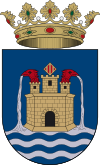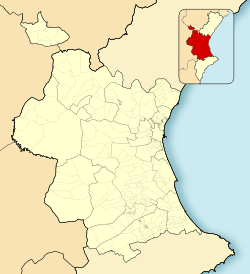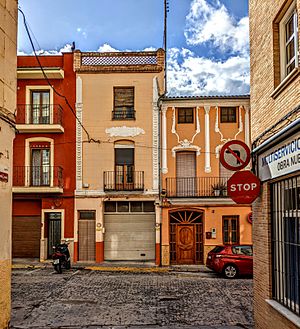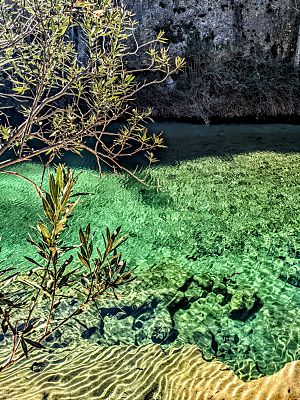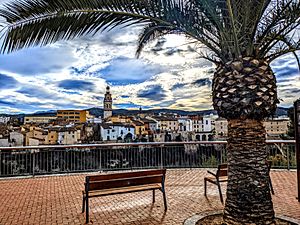Ontinyent facts for kids
Quick facts for kids
Ontinyent
|
|||
|---|---|---|---|
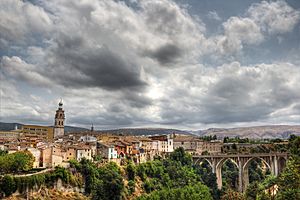 |
|||
|
|||
| Country | |||
| Autonomous community | |||
| Province | Valencia | ||
| Comarca | Vall d'Albaida | ||
| Judicial district | Ontinyent | ||
| Area | |||
| • Total | 125.43 km2 (48.43 sq mi) | ||
| Elevation | 382 m (1,253 ft) | ||
| Population
(2018)
|
|||
| • Total | 35,395 | ||
| • Density | 282.189/km2 (730.87/sq mi) | ||
| Demonym(s) | 36.019 ontinyentí, ontinyentina | ||
| Time zone | UTC+1 (CET) | ||
| • Summer (DST) | UTC+2 (CEST) | ||
| Postal code |
46870
|
||
| Official language(s) | Spanish and Valencian | ||
Ontinyent is a town in the Valencian Community of Spain. It is located in the Vall d'Albaida region. The town sits by the Clariano River and is connected by a railway. Ontinyent is also close to the beautiful Sierra de Mariola Natural Park.
This historic city has many old churches and grand houses. You can also see parts of its ancient city walls. Ontinyent was once famous for making cloth, paper, and furniture. It also traded in things like cereals, wine, and olive oil.
Did you know that Juan Roig, a Spanish billionaire who leads the Mercadona supermarket chain, went to school in Ontinyent?
Contents
Discovering Ontinyent's Past
Ontinyent has a long and interesting history. People have lived here for thousands of years!
Early Settlements and Roman Times
Scientists have found signs of human life from the end of the Stone Age. These discoveries were made at a place called Castellar. Later, during the Roman era, small farming villages appeared. One of these Roman settlements likely gave Ontinyent its name, pagus Untinianus. Over time, this name changed into versions like Ontinient and Ontinyent.
Muslim Influence in Ontinyent
The town of Ontinyent also has roots in the 11th century, when Muslims lived here. A famous poet named al-Untinyaní was born in Ontinyent. The castle of Ontinyent was an important stop on the road between Murcia and Valencia. While not many old buildings from this time remain, you can still see clues. For example, the famous Covetes dels Moros (Caves of the Moors) are found nearby. These caves were probably used to store grain for farming communities. They show how important Islamic culture was in the area.
Christian Conquest and Name Changes
In 1244, King Jaime I and his troops took control of Ontinyent. The town then became part of the Kingdom of Valencia.
In the 1700s, the way the area was governed changed. This also led to a change in the town's name. The Spanish form, Onteniente, became official. But later, in the late 20th century, the original name Ontinyent was brought back.
Ontinyent became an official city in 1904.
Ontinyent: A Land of Vineyards
The area around Ontinyent is well-known for its many vineyards. This region is often called the "Valencian Tuscany." The climate in the Vall d'Albaida has always been perfect for growing grapes. This means it's a great place to make wine!
Modernizing the City
As the textile industry changed, Ontinyent began to update itself. The city started many projects to improve its spaces and services.
Exciting City Projects
- The Sant Antoni neighborhood is getting a new public square. This will make the area more open and friendly for people.
- The city market will soon have a new café. This will offer indoor and outdoor seating. It's part of a growing trend for great food in the Valencian Community.
- Plaça de la Glorieta will be redesigned. It will become a major green space in the city. Many new trees will be planted, making it much greener.
- The Museo Textil de la Communidad Valenciana (Textile Museum) has been updated. It is located in old warehouses by the Clariano River.
- The Cantereria district will see old houses removed. A special park will be built by the Clariano River. This park can handle floods, protecting the area.
- Parts of the ancient city walls, called La Muralla Norte, are being fixed. This will make it easier to visit La Vila, the oldest part of the city. Workers even found a second tower during the repairs!
- A new hospital for Ontinyent is opening soon. It will have a special unit for brain injuries. This hospital will serve many nearby towns. The old hospital will then focus on long-term care.
Pou Clar: A Natural Spring
Just outside the city, you'll find the Pou Clar. This natural spring is a beautiful spot. It's a favorite place for people to swim and enjoy nature.
The Pou Clar is one of the biggest natural attractions in the Valencian Community. It has many pools, waterfalls, and lots of plants and fish. It even appeared in a beer advertisement in 2022!
Places to Explore in Ontinyent
Ontinyent offers many interesting places to visit.
- The Pont Vell: This is a stone bridge from the 16th century. It crosses the Clariano River. Recent digs showed that a tower on the bridge was actually an old mill.
- The Palau de la Vila: This old fortress sits by the Clariano River. It is in La Vila, the city's medieval walled area.
- La Vila: This is the name for the oldest part of the city. It's a maze of old houses, narrow streets, and colorful buildings. In the 15th century, Ontinyent was a very busy town. You can see this in its many historic buildings.
- Hotel Kazar: This impressive palace from the early 1900s is now a hotel. It was built in 1925 for the Mompó family.
- The Vineyards: You can explore the beautiful vineyards to the west of the city.
- The Mirador San Rafael: This "balcony" in the San Rafael neighborhood offers amazing views. You can see the old city, the Pont Vell, and the Pont de Santa Maria from here.
Moros i Cristians Festival
This exciting festival happens every August since 1860. It celebrates the Christian reconquest of the city from Muslim troops. This happened in the 13th century, led by King Jaime I.
During the festival, people reenact battles with cannons. They wear amazing costumes and have grand parades. A special song called "Chimo" is played. It was written in 1964 and is like an anthem for the festival.
Famous People from Ontinyent
- José Melchor Gomis (1791–1836): A composer who wrote the song Himno de Riego.
- Juan Carlos Ferrero (born 1980): A famous tennis player who was once ranked number one in the world.
See also
 In Spanish: Onteniente para niños
In Spanish: Onteniente para niños



